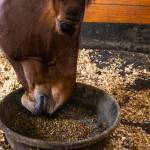Muscle Disorder Breed Prevalence Studied

Muscle disorders characterized by cramping, exercise intolerance, back pain, tremors, and/or weakness have been reported in various breeds. A number of designations such as tying-up syndrome, recurrent exertional rhabdomyolysis (RER), polysaccharide storage myopathy (PSSM), and equine polysaccharide storage myopathy (EPSM or EPSSM) have been used to describe these problems. Some attempts have been made to group the most common signs and relate them to different breeds or types of horses. For instance, the syndrome known as RER seemed to be found most commonly in nervous fillies of Thoroughbred, Standardbred, and Arabian breeding. On the other hand, signs of PSSM were more often associated with Quarter Horses, Paints, and Appaloosas, while some warmblood and draft breeds had a different set of signs that were labeled EPSM. However, it seemed impossible to avoid some overlap among breeds and disease signs.
Management changes related to exercise and diet (see references below) have been of great value in helping some horses with muscle disorders, but other horses with similar problems have not shown a significant positive response to these changes. Researchers now feel there are several factors, some of which probably have a genetic basis, causing the syndromes. Increased use of muscle biopsy has been helpful in subcategorizing the many types of pain, stiffness, and elevated muscle enzymes into specific clinical entities. This paper explains the particulars of equine polysaccharide myopathy; describes diagnostic techniques; and lists breeds known to be affected.
What is equine polysaccharide myopathy?
Equine polysaccharide storage myopathy (EPSM) is associated with abnormal muscle glycogen metabolism. Glycogen, the form of carbohydrate stored in the muscles and synthesized to fuel exercise, is made up of branched chains of molecules. During normal metabolism, enzymes break down the chains and branches so sugars can be released into the blood stream. In horses with EPSM, it is thought that both the branches or chains, or both, are not easily broken down, and supplies of glycogen build up in the tissues instead of being used. In some other species, this is due either to a mutation in, or a complete lack of, one or more of these enzymes. This situation may exist in horses, but has not yet been identified in the species.
What techniques are used to diagnose the disease?
Since its description in Quarter Horses in 1992, EPSM has been most commonly diagnosed by the demonstration of skeletal muscle fibers showing enzyme-resistant inclusions stained with periodic acid Schiff (PAS) reagent. This is a chemical that identifies the presence of glycogen as well as other complex carbohydrates (polysaccharides).
What breeds of horses have been affected?
Horses from a number of breeds and breed crosses have been diagnosed with EPSM, with up to 86% of tested individuals in some draft breeds reported to be affected. The list includes:
- Andalusian
- Anglo-Arab
- Appaloosa
- Appaloosa cross
- Arabian
- Belgian
- Belgian mule
- Belgian-TB cross
- Clydesdale
- Haflinger
- Miniature horse
- Pony (mixed-breed)
- Morgan
- Mustang
- Norwegian
- Fjord
- Paso Fino
- Percheron
- Percheron-Belgian
- Percheron-TB
- Pony of the Americas
- Quarter Horse
- QH-Arab cross
- Shire
- Standardbred
- Tennessee Walker
- Thoroughbred
- Warmblood
- Welsh cross pony
Is the diagnosis of EPSM always accurate and specific?
The authors of this report question that the disease is the same in all diagnosed individuals because not all horses show the same physical signs, muscle cell staining results, or disease progression. For example:
In some horses showing muscle cramping and other physical signs, examination of muscle tissue reveals abnormally abundant inclusions of glycogen, but the inclusions are of enzyme-sensitive rather than enzyme resistant glycogen. Quarter Horse foals may show physical signs several years before microscopic tissue examination reveals abnormal enzyme-resistant glycogen inclusions. Some horses show very few muscle fibers containing enzyme-resistant glycogen inclusions and numerous fibers containing enzyme-sensitive inclusions, yet some of the “normal” fibers still contain excessive glycogen. Such a horse could, by chance, have a biopsy that did not include any abnormal inclusions, and the animal could thus be incorrectly pronounced free of the disease. This might be significant if an animal was to be used for breeding.
What does this report tell us about the occurrence and management of equine polysaccharide storage myopathy among various breeds of horses?
The authors state, “Identification of the genetic cause or causes of polysaccharide storage myopathy will probably be required finally to determine whether different breeds really do share a common disease. In the meantime, muscle biopsy remains the gold standard test and, importantly, identifies horses that may well respond to dietary and management changes.”
The full text of this paper was published in Equine Veterinary Education, Vol. 19, Number 3 (2007).
The study “Breed susceptibility in equine polysaccharide storage myopathy,” was conducted by R Stanley and RJ Pierce.








